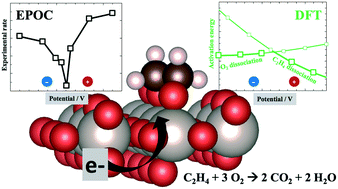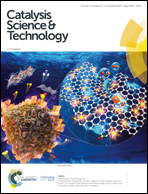Theoretical insight into the origin of the electrochemical promotion of ethylene oxidation on ruthenium oxide†
Abstract
In electrochemical promotion of catalysis (EPOC), the adsorption energies of the reactants and products, and subsequently the overall catalytic reaction rate, are modified by applying an electrochemical potential to the catalyst. In this paper, the oxidation of ethylene on ruthenium oxide was studied through carrying out experiments and theoretical modeling in order to elucidate the atomistic origin of EPOC. The experimental results show an increase in the reaction rate under negative and positive polarization. The density functional theory (DFT)-based surface free energies demonstrate that there is an increase in oxygen coverage on the ruthenium surface as a function of the potential, conforming with the backspillover model of EPOC. Furthermore, the DFT results demonstrate that the positive polarization and the associated electric field, which increase the work function, result in enhanced adsorption and facilitate cleavage of the C–C bond of ethylene. Under negative polarization, on the other hand, it is the oxygen activation that is facilitated. Together, these two pieces of the puzzle explain the experimentally observed increase in the ethylene oxidation rate as a function of positive and negative potential, proving the effect of an electric field on the adsorption rate and activation energy of ethylene oxidation.

- This article is part of the themed collection: 2019 Catalysis Science & Technology HOT Articles


 Please wait while we load your content...
Please wait while we load your content...